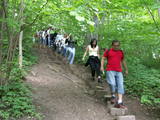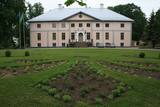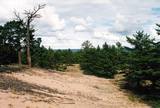| Nr | Name | Beschreibung |
|---|---|---|
|
Ein auf dem südostlichen Teil des Dombergs 1808 – 1810 gebautes Gebäude nennt man Wissenschaftsperle. Im Observatorium ist ein attraktives Museum eingerichtet. |
||
|
Also known as Lake Jēsis or Lake Iesis, this is the lake in Latvia which has the largest number of islands. Many literary sources and encyclopaedias in the 20th century claimed that there were 69 islands in the lake, but that was an exaggeration, because apparently the authors took sandbars overgrown with reeds and other plants to be islands. The true number is approximately two times lesser. The largest number of islands can be found in the north-eastern part of the lake. The largest one is Lielā Lāča (Big Bear) Island (45 ha). A farm was on the island at one time. The islands and the oak trees that are on the shores of the lake – the Piļoru and Pahatnīku stands of trees – are in a restricted environmental reserve. |
||
|
Es ist ein Ort, wo man kurze und lange Spaziergänge machen kann. Hier ist der 1,6 km lange Pfad von Sprīdītis (mit Holzskulpturen der Helden aus den Märchen der Schriftstellerin Anna Brigadere), der 3,8 km lange Waldlehrpfad und der 8 km (eine Richtung) lange Landschaftspfad von Augšzeme. Alle Pfade befinden sich in einer subglazialen Bettung, wo sich einer nach dem anderen kleine Seen und Sümpfe befinden, die mit Durchflüssen verbunden sind. Zum Schutz der Landschaft und anderer Werte ist hier ein Naturschutzgebiet eingerichtet worden. An der Stelle, wo die Pfade anfangen (unweit von Pilskalne), ist der ungefähr 30 Meter hohe Hügel Melnaiskalns (Schwarzberg oder der Burgberg von Rāmava) zu besichtigen. |
||
|
Birch juice syrup with reverse osmosis is obtained. Technologically impressive view of 1.5 tons of water squeezed out of birch sap per hour. Here, reverse osmosis equipment can press 95% of pure water from birch sap. As a result, the sugar content of the remaining birch sap concentrate reaches 33% Brix. The concentrate is frozen and sold. |
||
|
Das Landgutsschloss wurde in der Mitte des 18. Jh. als ein Jagdschloss gebaut, gehörte dem Adelsgeschlecht von Medem. Das Eingangsportal des Schlosses (Spätbarock) und das Marmorrelief darüber mit einem Wappen der Allianz der Adelsgeschlechte von Medem und Keizerling sind ein hervorragendes Kunstdenkmal aus dem 18. Jh. |
||
|
Die zweitgrößte Stadt Litauens und von 1920 bis 1939 die vorläufige Hauptstadt. Altstadt, Rathaus (16 Jh.), Basilikum-Kathedrale St. Peter und Paul (15 Jh.), Perkūnas-Haus (Donnerhaus, 15 Jh.), Laisves Alee, Čiurlionis-Kunstmuseum und Teufelsmuseum. |
||
|
This is a forested island in the Bay of Finland which is the 6th largest Estonian island and is found 14 km to the N of Tallinn. Two decades ago it was a closed zone, because the Soviet Union had a highly secretive manufacturing plant for maritime mines here.
|
||
|
This is the thickest wild pear tree in Latvia. The tree is particularly beautiful when it is blossoming.
|
||
|
Auf dem Barfußweg im Agrotourismushof Survilai in Šveicarija im Kreis Jonava kann man die Natur mit allen 5 Sinnen erfassen! Der Belag ist ausgesprochen abwechslungsreich: Kienzapfen, Moor, Torf, Lehm, Kies, abgeschliffene Glassplitter, Kiefernnadeln, Stroh, Hindernisstrecken und vieles andere. Der Pfad ist über einen Kilometer lang, sodass Sie die vielfältigsten, gänzlich unerwarteten Empfindungen wahrnehmen können, zusammen mit positiven Emotionen und einem Energieschwall. |
||
|
Die Besitzer zuchten Shiitakepilze in einem Wald und bieten eine Exkursion mit Erzählung über die Zucht der Pilze und ihre gute Eigenschaften an. Erwerb der Pilze, Beratung. Die Besitzer bieten ökologische landwirtschaftliche Produkte und Honig an.
|
||
|
Um den Fluss Daugava aus einer anderen Sicht zu sehen, kann man vom Bäckerei-Geschäft der Firma „Liepkalnu maiznīca” eine Ausfahrt mit einem Langschiff der Wikinger „Lāčplēsis” machen, der gleichzeitig eine Gruppe von 24 Personen an Bord aufnehmen kann. Daugava war schon von alters her ein bedeutender Wanderungskorridor nicht nur für verschiedene Pflanzen- und Tierarten, die dadurch auf das jetzige Territorium Lettlands “gekommen” sind , sondern auch für Leute und Stämme, die die Daugava-Ufer und die Ostseeküste besiedelten. |
||
|
Das Café befindet sich im Zentrum von Aglona an der Straße nach Dagda (P 60). Lettische Küche: Schweinefleischfrikadellen, Kartoffeln mit Hering und Sauerrahm, Quarkcreme mit Erdbeeren. Das besondere Gericht: Rouladen. |
||
|
“Rūme” - vieta Sēlijā, Zasā, kur tiekas radoši amatnieki un īsti Sēlijas zinātāji, kas lepojas ar savu sēļu mēli un sēļu tērpiem. Tieši šajā amatniecības centrā bieži vien amatnieki atrāda savus darba augļus, un cilvēki pulcējas uz dažādiem pasākumiem. |
||
|
Die Papierfabrik von Līgatne ist das einzige noch arbeitende Unternehmen seiner Art in Lettland, aber ihr historisches Zentrum steht unter Denkmalschutz. Das Zentrum kann man unter der Leitung eines örtlichen Reiseleiters kennenlernen, der über das soziale Modell der Arbeiter und der Verwaltung der Fabrik am Ende des 19. Jhs. und am Anfang des 20. Jhs. erzählt, als hier für die Bedürfnisse der Fabrik Wohnhäuser, eine Schule, ein Entbindungshaus, ein, Krankenhaus, ein Club und andere Gebäude gebaut wurden, die sich bis heute gut erhalten haben. |
||
|
Uzpludinātās Zveņģupītes kreisajā krastā – neliela meža pudura malā (170 m no Rīgas – Daugavpils šosejas (A 6)) atrodas 1991. g. atklātais (autors: Juris Zihmanis) akmens – piemiņas vieta 17. gs. Lielvārdes meitenei Katrīnai, kura kā ragana sadedzināta sārtā. |
||
|
The restaurant is located half an hour's drive from Madona. Every time dinner "Evening on the Lake" is chosen by other chefs. |
||
|
Der Ķemeri Nationalpark wurde 1997 gegründet und umfaßt vor allem Feuchtgebiete – die flachen Küsten der Rigaer Bucht, einen überwucherten Küstensee, riesige Sümpfe, feuchte Wälder, Moore und überschwemmte Wiesen. Der Nationalpark ist enorm wichtig für den Schutz der Pflanzen (25% der in Lettlands Roter Liste erfaßten Pflanzen findet man hier) und Tiere, besonders Nist- und Zugvögel. Das Große Ķemeri Moor ist eins der größten Moore in Lettland. Es gibt auch andere, wie das Zaļais und das Raganu Moor. Die gewaltigen Moore sind auch wichtig wegen der Schwefelquellen und dem Heilschlamm. Für das einst berühmte Ķemeri Kurbad war das die Grundlage. Die meisten der kulturellen und historischen Objekte im Ķemeri Nationalpark stehen in Verbindung mit der Meeresküste als Ort für Freizeit und Erholung. Es gibt Naturlehrpfade, Fahrradrouten, Wanderwege, Vogelbeobachtungstürme und andere Einrichtungen. Das Besucherzentrum befindet sich im kürzlich renovierten „Meža mājā” (Waldhaus) in Ķemeri.
|
||
|
Diese Route führt Sie in die Region Kurzeme, wo Sie traditionelle Speisen der Region kennenlernen. Die Tour beginnt in Riga und bringt Sie in einige der schönsten Naturregionen, in denen Sie wandern können, was wiederum den Appetit anregen wird. Auf dem Dieniņas-Fischerhof können Sie Räucherfisch essen, in Kolka an einem Workshop im Backen von „Sklandrausis“ (eine traditionelle Möhrenpirogge) teilnehmen, im Nationalpark Slītere Fischerdörfer besuchen und in den Gaststätten von Ventspils raffiniert zubereitete Gerichte genießen. Schöne Attraktionen auf dem Weg sind die Ostseesteilküste bei Jūrkalne und das mittelalterliche Städtchen Kuldīga. In einer Wassermühle aus dem 19. Jahrhundert, die heute ein Bio-Bauernhof ist, gibt die Gastgeberin einen Kochkurs in lokaler Küche mit Gerichten aus Damwild, Forelle, Gemüse und Obst. Die letzte Station vor der Rückkehr nach Riga ist das Schokoladenmuseum in Pūre. |
||
|
Auf dieser Tour werden lokale Traditionen der Weinherstellung mit dem Charme des Landlebens und einiger mittelalterlichen Schlösser und Landgüter kombiniert. Die Tour führt nach Sigulda, wo sich an den steilen Ufern des Urstromtals des Flusses Gauja drei Burgen befinden. Sie besuchen die mittelalterlichen Burgen von Turaida und Sigulda und danach fahren Sie zum Landgut von Krimulda, wo Sie Weine verkosten können. Sie besuchen auch eine Familie in Sigulda, die Wein herstellt. Am nächsten Tag haben Sie eine Führung in dem historischen Dorf Ligatne und verkosten lokale Weine in einer Sandsteinhöhle, die dieser Region charakteristisch ist. Weiter führt die Tour zu den eindrucksvollen Ruinen der mittelalterlichen Burg von Cesis und zum Landgut von Ungurmuiza, das das einzige erhaltene barocke Landgut aus Holz in den baltischen Staaten ist. Sie übernachten in dem ehemaligen Landgut von Dikli, das heute ein luxuriöses Hotel ist. Am nächsten Tag führt die Tour entlang der Küste, wo sich das Museum des größten Lügners der Welt – Münchhausen befindet. Sie können auch einen Spaziergang an der sandigen Küste unternehmen. Danach besuchen Sie einen lokalen Weinhersteller und verkosten verschiedene Weine, aber im Landgut von Birini genießen Sie eine Mahlzeit. Sie können vor der Rückfahrt nach Riga einen entspannenden Spaziergang in dem großen Park dieses Landgutes unternehmen. |
||
|
Köstliche, hausgemachte Konserven und andere kulinarische Waren für alle, die lokale Produkte schätzen. Angeboten werden lokal zubereitete Gerichte und Konserven zum Kaufen. |
||




























